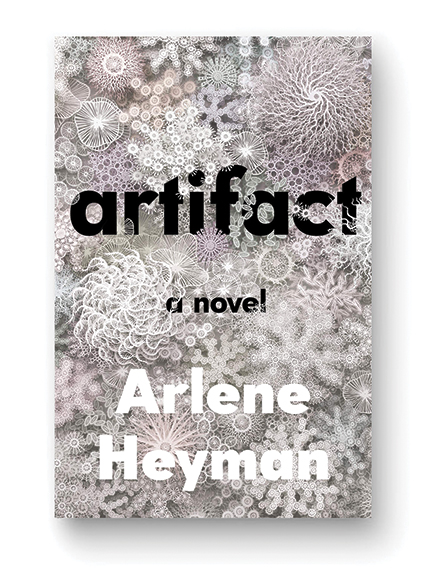
By Arlene Heyman. Bloomsbury Publishing, 288 pages, $27
Arlene Heyman’s long-gestating first novel dissects the trials and traumas of a woman of a certain era.
By Julia M. Klein
If Lottie, the rat-dissecting researcher of Artifact, seems familiar, it’s because we’ve encountered her before: she was the protagonist of the identically titled short story in Arlene Heyman M’73’s fine debut collection, Scary Old Sex (Bloomsbury USA, 2016).
Lottie’s complaints may seem familiar as well. She is an aspiring scientist with a history of righteous grievances, both academic and personal. In her first published novel, Heyman gives Lottie a complicated, engrossing backstory, including a rambunctious adolescence, a failed marriage to her high school sweetheart, a sexual assault, three children (plus an obstreperous stepdaughter), and years of professional frustration.
Heyman’s own backstory [“Arts,” Jul|Aug 2016] is at least as interesting. Before becoming a Manhattan-based psychiatrist, she studied with the poet Delmore Schwartz and the novelist Bernard Malamud, who became a mentor, lover, and friend. After some early literary success, Heyman turned her focus to medicine. Scary Old Sex, a gritty look at imperfect relationships and old-age sexuality, seemed to burst out of nowhere, and received rapturous reviews.
Like the short stories, Artifact, which once clocked in at 793 pages, has been in the works for decades. In her acknowledgments, Heyman says Malamud critiqued her 1980 manuscript. She has since manicured the book to a more manageable length and set it firmly in the 20th century, beginning the narrative in 1984 and then flashing back to Lottie’s earlier life.
As a result, Lottie’s professional tribulations—including graduate school classmates who alternatively mock or ignore her—make sense in context. How powerfully they resonate with contemporary readers may be an individual matter. While sexism and misogyny persist, in the sciences as elsewhere, they are arguably not quite so unvarnished.
What is most modern in Artifact—as in the short stories—is Heyman’s unsparingly direct descriptions of human sexuality, as well as gory laboratory procedures. Here, for example, is Lottie in her lab, slaughtering rats to study their salivary glands:
She raised the paper cutter blade and positioned the animal’s head on the platform, his squirming body just off the edge. His pink feet kicked the air. He began defecating black pellets, urinating in spasms on her glove. She brought the blade down crunching through the bottom of his neck. The head lay on the platform.
At this point in the narrative, Lottie is seething at a rejection by a microscopy journal, which takes her to task for her research methods. One critic has suggested that her submitted paper contains “accidental and random findings … no more than a collection of artifacts.”
After the opening scenes, Heyman returns us to Lottie’s Michigan childhood, with an emotionally absent, literary mother, who named her for Charlotte Brontë, and a stern, patriarchal father. We learn little about her three siblings and are left to ponder whether her memory of a baby brother given up for adoption is accurate.
The adolescent Lottie finds love and acceptance in a precocious sexual relationship with a popular classmate, Charlie Hart, a star running back. “She admired him with her future anatomist’s eye,” Heyman writes. They couple early and often, beginning when Lottie is just 14. Heyman describes their erotic adventures, apparently observed by a voyeuristic classmate, with undisguised relish.
For Lottie, though, pleasure leads to sorrow and pain. At 16, pregnant, she faces first her father’s wrath, then a miscarriage. Later, at the University of Michigan, Charlie’s brilliant football career is cut short by an injury. Despite this unpromising start, the couple—“an uneasy, off-kilter twosome”—marry and move to Texas, where Charlie desultorily studies economics in graduate school, and Lottie, bored at home, takes a job as a lab tech.
That their marriage, after producing a daughter, falters is not a surprise. Heyman never makes clear exactly why Charlie withdraws from Lottie, but his frequent nights out suggest an affair. Meanwhile, Lottie, too, finds another love interest: a kind-hearted, Armenian American pediatric resident, George Kenadjian, who, on first meeting, teaches her how to draw blood. There’s a mutual attraction, or so it seems. But even after leaving her increasingly absent husband, Lottie can’t quite act on it. Instead, she drives off to graduate school at the University of Wisconsin, her daughter in tow, and the good doctor disappears entirely from the story.
It is there that the novel’s most startling incident occurs: an initially consensual sexual encounter with an old acquaintance, who inhabits the territory between cluelessness and sociopathy, devolves into rape. Heyman takes us into the room and Lottie’s psyche as her desire turns to terror. Grabbing a bread knife, Lottie manages to draw her assailant’s blood—the drawing of blood is one of the novel’s motifs—and to throw him out. But he never really pays for his act—an outcome that, however true to life, may be hard for readers to accept.
Like many women of an earlier generation, Lottie chooses to deal with the profound psychological impacts of sexual violence largely on her own. In time, her trauma fades. Heyman allows herto plunge into a new life, in New York, with a medical school professorship and a fulfilling marriage. Until, as in the short story, Lottie’s obsessive focus on workleads to near-disaster.
Artifact itselfis at once absorbing and episodic. Heyman piles up incidents, keeping the narrative moving and the reader involved. Not every plot twist makes sense; not every loose end is tied up. Despite its author’s day job, Artifact is less psychological novel than contemporary picaresque, with an imperfect heroine who flails her way, sometimes gracelessly, through obstacles, but manages to be standing, and modestly triumphant, at the end.
Julia M. Klein is a frequent contributor to the Gazette.




